Typomorphism of Native Gold (Geological-Industrial Types of Gold Deposits in the North-East of Russia)
Abstract
1. Introduction
2. Regional Geological Setting and GITs of Gold Deposits
2.1. Geological and Structural Position of Northeast Asia
2.2. GITs of Gold Deposits
2.2.1. Gold–Arsenic-Sulfide in Black Shale GIT
Natalka Deposit
Maldyak Deposit
Karalveem Deposit
Degdekan Deposit
2.2.2. Gold–Quartz Veins in Granitoids GIT
Shkolnoye Deposit
Butarnoye Deposit
Dorozhnoye Deposit
Maltan Deposit
2.3. Gold–Silver Adularia GIT
2.3.1. Kubaka Deposit
2.3.2. Kupol Deposit
2.3.3. Olcha Deposit
2.3.4. Burgali Deposit
2.3.5. Primorskoye Deposit
2.3.6. Dalnee Deposit
3. Research Methods and Objects
3.1. Research Objects
3.2. Research Methods
4. Results
4.1. Typomorphic Features of Native Gold
4.1.1. Gold–Arsenic-Sulfide in Black Shale Strata GIT
Fineness of Native Gold
Trace Elements
Minerals in Intergrowth
Internal Structures
4.1.2. Gold–Quartz Veins in Granitoids GIT
Fineness of Native Gold
Trace Elements
Mineral Intergrowths
Internal Structures
4.1.3. Gold–Silver Adularia in Volcanogenic Strata GIT
Fineness of Native Gold
Trace Elements
Mineral Intergrowths
Internal Structures
5. Discussion
- Orogenic [4]—hydrothermal-metamorphogenic in sedimentary strata (in most cases, these are black shale strata that have experienced metamorphism, mid-deep and deep (gold-sulfide quartz in sedimentary strata);
- Volcanogenic (epithermal) [52]—in volcanic belts of any age associated with volcanic activity in basic volcanic rocks of the oxidized type, shallow (gold–silver adularia).
6. Conclusions
Author Contributions
Funding
Acknowledgments
Conflicts of Interest
References
- Kreyter, V.M. Industrial types of deposits. In Theoretical Foundations of Prospecting and Exploration of Solid Minerals; Nedra: Moscow, Russia, 1968; pp. 9–27. (In Russian) [Google Scholar]
- Shapovalov, V.S. About industrial types of own gold deposits of the Russian Federation. In Collection of Abstracts of the IX International Scientific and Practical Conference, Proceedings of the Scientific and Methodological Foundations of Forecasting, Prospecting, Evaluation of Deposits of Diamonds, Precious and Non-Ferrous Metals, Moscow, Russia, 17–19 April 2019; TsNIGRI Publ: Moscow, Russia, 2019; pp. 156–157. (In Russian) [Google Scholar]
- Konstantinov, M.M.; Struzhkov, S.F.; Aristov, V.V. Geological and industrial grouping of gold deposits. Mineral Resources of Russia. Econ. Manag. 2007, 4, 15–18. (In Russian) [Google Scholar]
- Groves, D.I.; Goldfarb, R.J.; Gebre-Mariam, M.; Hagemann, S.G.; Robert, F. Orogenic gold deposits: A proposed classification in the context of their crustal distribution and relationship to other gold deposit types. Ore Geol. Rev. 1998, 13, 7–27. [Google Scholar] [CrossRef]
- Robert, F.; Poulsen, K.H.; Dubé, B. Gold Deposits and Their Geological Classification. In Geophysics and Geochemistry at the Millennium: Proceedings of Exploration 97: Fourth Decennial International Conference on Mineral Exploration; Gubins, A.G., Ed.; Prospectors and Developers Association of Canada: Toronto, ON, Canada, 1997; pp. 209–220. [Google Scholar]
- Titley, S.T.; Zurcher, L. Regional geology and ore-deposit styles of the trans-border region, southwestern North America. In Ores and Orogenesis: Circum-Pacific Tectonics, Geologic Evolution, and Ore Deposits; Arizona Geological Society: Tucson, AZ, USA, 2008; pp. 75–294. [Google Scholar]
- Sillitoe, R.H. Special Paper: Major Gold Deposits and Belts of the North and South American Cordillera: Distribution, Tectonomagmatic Settings, and Metallogenic Considerations. Econ. Geol. 2008, 103, 663–687. [Google Scholar] [CrossRef]
- Nguimatsia, D.F.W.; Bolarinwa, A.T.; Yongue, R.F.; de Dieu Ndikumana, J.; Olajide-Kayode, J.O.; Olisa, O.G.; Abdu-Salam, M.O.; Kamga, M.A.; Djou, E.S. Diversity of Gold Deposits, Geodynamics and Conditions of Formation: A Perspective View. Open J. Geol. 2017, 7, 1690–1709. [Google Scholar] [CrossRef][Green Version]
- Nikolaeva, L.A.; Gavrilov, A.M.; Nekrasova, A.N.; Yablokova, S.V.; Pozdnyakova, N.N.; Shatilova, L.V. Typomorphism of native gold. In Guidelines for Exploration Work; Krivtsov, A.I., Vartanyan, S.S., Eds.; TsNIGRI: Moscow, Russia, 2021. (In Russian) [Google Scholar]
- Savva, N.E.; Preis, V.K. Atlas of Native Gold of the North-East of the USSR; Nauka: Moscow, Russia, 1990. (In Russian) [Google Scholar]
- Pal’yanova, G.A. Physicochemical modeling of the coupled behavior of gold and silver in hydrothermal processes: Gold fineness, Au/Ag ratios and their possible implications. Chem. Geol. 2008, 255, 399–413. [Google Scholar] [CrossRef]
- Morrison, G.W.; Rose, W.J.; Jaireth, S. Geological and geochemical controls on the silver content (fineness) of gold in gold-silver deposits. Ore Geol. Rev. 1991, 6, 333–364. [Google Scholar] [CrossRef]
- Minter, W.E.L.; Goedhart, M.; Knight, J.; Frimmel, H.E. Morphology of Witwatersrand gold grains from the Basal reef: Evidence for their detrital origin. Econ. Geol. 1993, 88, 237–248. [Google Scholar] [CrossRef]
- Knight, J.B.; Mortensen, J.K.; Morison, S.R. Lode and placer gold composition in the Klondike district Yukon Territory, Canada, implications for the nature and genesis of Klondike placer and lode gold. Econ. Geol. 1999, 94, 649–664. [Google Scholar] [CrossRef]
- Gammons, C.H.; Williams-Jones, A.E. Hydrothermal geochemistry of electrum; thermodynamic constraints. Econ. Geol. 1995, 90, 420–432. [Google Scholar] [CrossRef]
- Olivo, R.; Gauthier, M.; Bardoux, M. Palladian gold from the Caue iron mine, Itabira District, Minas Gerais, Brazil. Mineral. Mag. 1994, 58, 579–587. [Google Scholar] [CrossRef]
- Gas’kov, I.V. Major impurity elements in native gold and their association with gold mineralization settings in deposits of Asian folded areas. Russ. Geol. Geophys. 2017, 58, 1080–1092. [Google Scholar] [CrossRef]
- Cabral, A.R.; Lehmann, B.; Kwitko, R.; Jones, R.D. Palladian gold and palladium arsenide–antimonide minerals from Gongo Soco iron ore mine, Quadrilátero Ferrífero, Minas Gerais, Brazil. Appl. Earth Sci. 2002, 111, 74–80. [Google Scholar] [CrossRef]
- Chapman, R.J.; Leake, R.C.; Moles, N.R.; Earls, G.; Cooper, C.; Harrington, K.; Berzins, R. The application of microchemical analysis of gold grains to the understanding of complex local and regional gold mineralization: A case study in Ireland and Scotland. Econ. Geol. 2000, 95, 1753–1773. [Google Scholar]
- Chapman, R.J.; Mortensen, J.K. Application of microchemical characterization of placer gold grains to exploration for epithermal gold mineralization in regions of poor exposure. J. Geochem. Explor. 2006, 91, 1–26. [Google Scholar] [CrossRef]
- Chapman, R.J.; Leake, R.C.; Bond, D.P.G.; Stedra, V.; Fairgrieve, B. Chemical and Mineralogical Signatures of Gold Formed in Oxidizing Chloride Hydrothermal Systems and their Significance within Populations of Placer Gold Grains Collected during Reconnaissance. Econ. Geol. 2009, 104, 563–585. [Google Scholar] [CrossRef]
- Palyanova, G.A.; Savva, N.E. Sulfides of gold and silver: Composition, mineral associations, formation conditions. Chem. Technol. 2007, 8, 421–442. [Google Scholar]
- Palyanova, G.A. Gold and Silver Minerals in Sulfide Ore. Geol. Ore Depos. 2020, 62, 383–406. [Google Scholar] [CrossRef]
- Petrovskaya, N.V. Native Gold; Nauka: Moscow, Russia, 1973. (In Russian) [Google Scholar]
- Boyle, R.W. The geochemistry of silver and its deposits. Bull. Geol. Surv. Can. 1968, 160, 264. [Google Scholar]
- Fersman, A.E. Selected Works; Academizdat: Moscow, Russia, 1953; Volume 2. (In Russian) [Google Scholar]
- Yushkin, N.P. Theory and Methods of Mineralogy; Nauka: Leningrad, Russia, 1977. (In Russian) [Google Scholar]
- Yushkin, N.P. Mineralogical mapping and predictive prospecting and evaluation practice. In Mineralogical Mapping and Indicators of Mineralization; Nauka: Leningrad, Russia, 1990; pp. 4–17. (In Russian) [Google Scholar]
- Khanchuk, A.I. (Ed.) Geodynamics, Magmatism and Metallogeny of the East of Russia: In 2 Books; Dalnauka: Vladivostok, Russia, 2006. (In Russian) [Google Scholar]
- Sokolov, S.D. Essay on the tectonics of the northeast of Asia. Geotectonics 2010, 6, 60–78. [Google Scholar]
- Laverov, N.P.; Rundqvist, D.V. (Eds.) Large and Super-Large Deposits of Ore Minerals; IGEM RAN: Moscow, Russia, 2006; Volume 3, pp. 155–179, 179–203, 213–255. (In Russian) [Google Scholar]
- Kondratiev, M.N.; Savva, N.E.; Gamyanin, G.N.; Kolova, E.E.; Semyshev, F.I.; Malinovsky, M.A.; Kondratiev, E.A. New data on the structure, mineralogy and geochemistry of the gold deposit Karalveem (Chukotka). Domest. Geol. 2017, 3, 26–44. [Google Scholar]
- Akinin, V.V.; Voroshin, S.V.; Gelman, M.L. SHRIMP dating of metamorphic xenoliths from lamprophyre at the Degdekan gold deposit: On the history of transformations of the continental crust in the Ayan-Yuryakh anticlinorium (Yano-Kolyma fold system). Geology 2003, 2, 142–146. [Google Scholar]
- Volkov, A.V.; Savva, N.E.; Sidorov, A.A.; Prokofiev, V.Y.; Goryachev, N.A.; Voznesensky, S.D.; Alshevsky, A.V.; Chernova, A.D. The Shkolnoe gold deposit in the North-East of Russia. Geol. Ore Depos. 2011, 53, 1–19. [Google Scholar] [CrossRef]
- Akinin, V.V.; Prokopiev, A.V.; Toro, J.; Miller, E.L.; Wooden, J.; Goryachev, N.A.; Alshevsky, A.V.; Bakharev, A.G.; Trunilina, V.A. U–Pb shrimp ages of granitoides from the main batholith belt (North East Asia). Dokl. Earth Sci. 2009, 426, 216–221. [Google Scholar] [CrossRef]
- Volkov, A.V.; Cherepanova, N.V.; Prokofiev, V.Y.; Savva, N.E.; Smilgin, S.V.; Trubkin, N.V.; Alekseev, V.Y. Gold deposit in the Butarny granite stock (North-East of Russia). Geol. Ore Depos. 2013, 55, 214–237. [Google Scholar] [CrossRef]
- Savva, N.E.; Palyanova, G.A.; Kolova, E.E. Gold and silver minerals and condition of their formation at the Dorozhnoye deposit (Magadan region Rossia). Nat. Resour. 2014, 5, 478–495. [Google Scholar]
- Volkov, A.V.; Prokofiev, V.Y.; Savva, N.E.; Sidorov, A.A.; Byankin, M.A.; Uyutnov, K.V.; Kolova, E.E.K. Conditions for the formation of the Kupol gold-silver deposit in the north-east of Russia based on the study of fluid inclusions. Geol. Ore Depos. 2012, 54, 293–301. [Google Scholar]
- Savva, N.E.; Pal’yanova, G.A.; Byankin, M.A. The problem of genesis of gold and silver sulfides and selenides in the Kupol deposit (Chukot Peninsula, Russia). Russ. Geol. Geophys. 2012, 53, 457–466. [Google Scholar] [CrossRef]
- Savva, N.E.; Shakhtyrov, V.G. Olcha gold-silver deposit: Tectonic position, structure, material characteristics. Geol. Ore Depos. 2011, 53, 460–484. [Google Scholar] [CrossRef]
- Volkov, A.V.; Prokofiev, V.Y.; Savva, N.E.; Kolova, E.E.; Sidorov, A.A. Geochemical features of the ore-forming fluid of the Paleozoic Au-Ag epithermal Olcha deposit (North-East Russia). Dokl. Earth Sci. 2013, 450, 1–5. [Google Scholar] [CrossRef]
- Savva, N.E. Silver Mineralogy of the North-East of Russia. In Proceedings of the SVKNII FEB RAS; Sidorov, A.A., Ed.; Triumph: Moscow, Russia, 2018; 544p. (In Russian) [Google Scholar]
- Volkov, A.V.; Savva, N.E.; Ishkov, B.I.; Sidorov, A.A.; Kolova, E.E.; Murashov, K.Y. The epithermal Au-Ag deposit of Burgali in the Paleozoic Kedon volcanic belt (Northeast of Russia). Geol. Ore Depos. 2021, 63, 40–62. [Google Scholar] [CrossRef]
- Savva, N.E.; Volkov, A.V.; Prokofiev, V.Y.; Kolova, E.E.; Murashov, K.Y. Epithermal Ag-Au deposit Primorskoye (North-East of Russia): Geological structure, mineralogical and geochemical features and conditions of ore formation. Geol. Ore Depos. 2019, 1, 52–74. [Google Scholar]
- Gundobin, G.M.; Zakharov, M.N.; Smirnov, V.N.; Kravtsova, R.G. New data on the geochronology of igneous formations of the Even volcanic zone of the Okhotsk-Chukotka belt and associated ore mineralization. In Geochronology of Granitoids of the Mongol-Okhotsk Belt; Nauka: Moscow, Russia, 1980; pp. 145–156. (In Russian) [Google Scholar]
- Kravtsova, R.G.; Dril, S.I.; Almaz, Y.A.; Tatarnikov, S.A.; Vladimirova, T.A. The first data on the Rb-Sr age and isotope composition of gold-silver ores of the Dal’nego deposit (Even ore district, North-East of Russia). Dokl. Earth Sci. 2009, 428, 240–243. [Google Scholar] [CrossRef]
- Kostyrko, N.A.; Romanenko, I.N. Mineralogy of one of the near-surface gold-silver deposits in the North-East of the USSR. In Mineralogy and Geochemistry of Ore Deposits of the North-East of the USSR; SVKNII FEB RAS: Magadan, Russia, 1978; pp. 55–67. (In Russian) [Google Scholar]
- Lantsev, I.P.; Nikolaeva, L.A.; Badalova, R.P.; Denisova, L.N. On the Question of the Distribution of Impurity Elements in Native Gold from Various Deposits; TsNIGRI: Moscow, Russia, 1971; Volume 1, pp. 130–137. (In Russian) [Google Scholar]
- Vyalsov, L.N. Status and ways of development of research into the optical properties of ore minerals. In Endogennye Ore Deposits; Nauka: Moscow, Russia, 1980; pp. 230–265. (In Russian) [Google Scholar]
- Stimac, J.; Goff, F.; Goff, C.J. Chapter 46: Intrusion-Related Geothermal Systems. In The Encyclopedia of Volcanoes; Academic Press: Cambridge, MA, USA, 2015; pp. 799–822. [Google Scholar]
- Vikent’eva, O.V.; Prokofiev, V.Y.; Gamyanin, G.N.; Goryachev, N.A.; Bortnikov, N.S. Intrusion-related gold-bismuth deposits of North-East Russia: PTX parameters and sources of hydrothermal fluids. Ore Geol. Rev. 2018, 102, 240–259. [Google Scholar] [CrossRef]
- Volkov, A.V.; Sidorov, A.A.; Savva, N.E.; Kolova, E.E.; Chizhova, I.A.; Murashov, K.Y. The Geochemistry of Volcanogenic Mineralization in the Northwestern Segment of the Pacific Ore Belt: Northeast Russia. J. Volcanol. Seismol. 2017, 11, 6389–6406. [Google Scholar] [CrossRef]
- Gamyanin, G.N.; Nekrasov, I.; Zhdanov, J.J.; Leskova, I.V. Auroantimonat—A new natural compound of gold. Dokl. Akad. Nauk SSSR Mineral. 1988, 301, 947–950. [Google Scholar]
- Chudnenko, K.V.; Palyanova, G.A.; Anisimova, G.S.; Moskvitin, S.G. Physicochemical modeling of formation of natural Ag-Au-Hg solid solutions: Kyuchyus deposit (Yakutia, Russia) as an example. Appl. Geochem. 2015, 55, 138–151. [Google Scholar] [CrossRef]
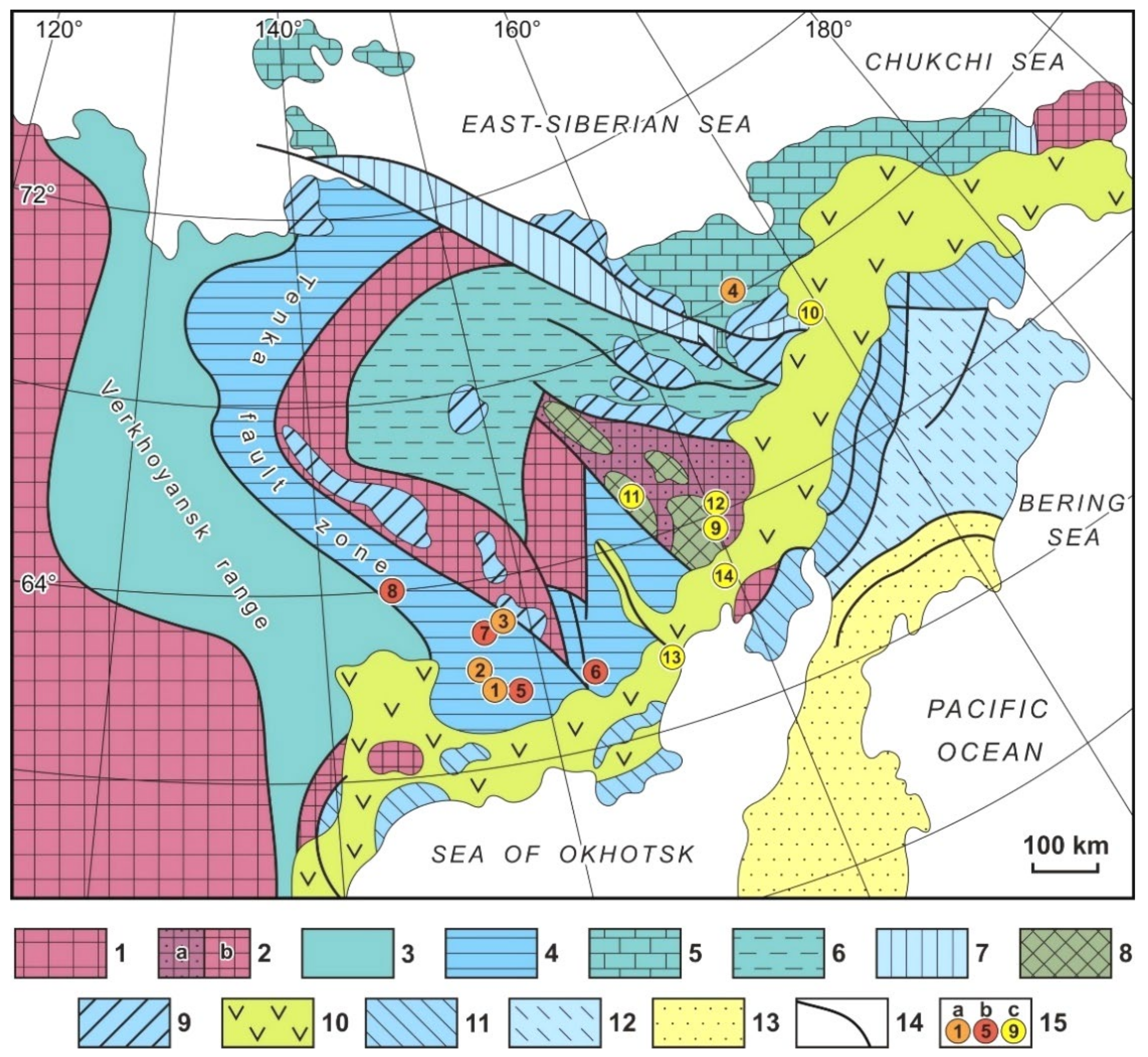
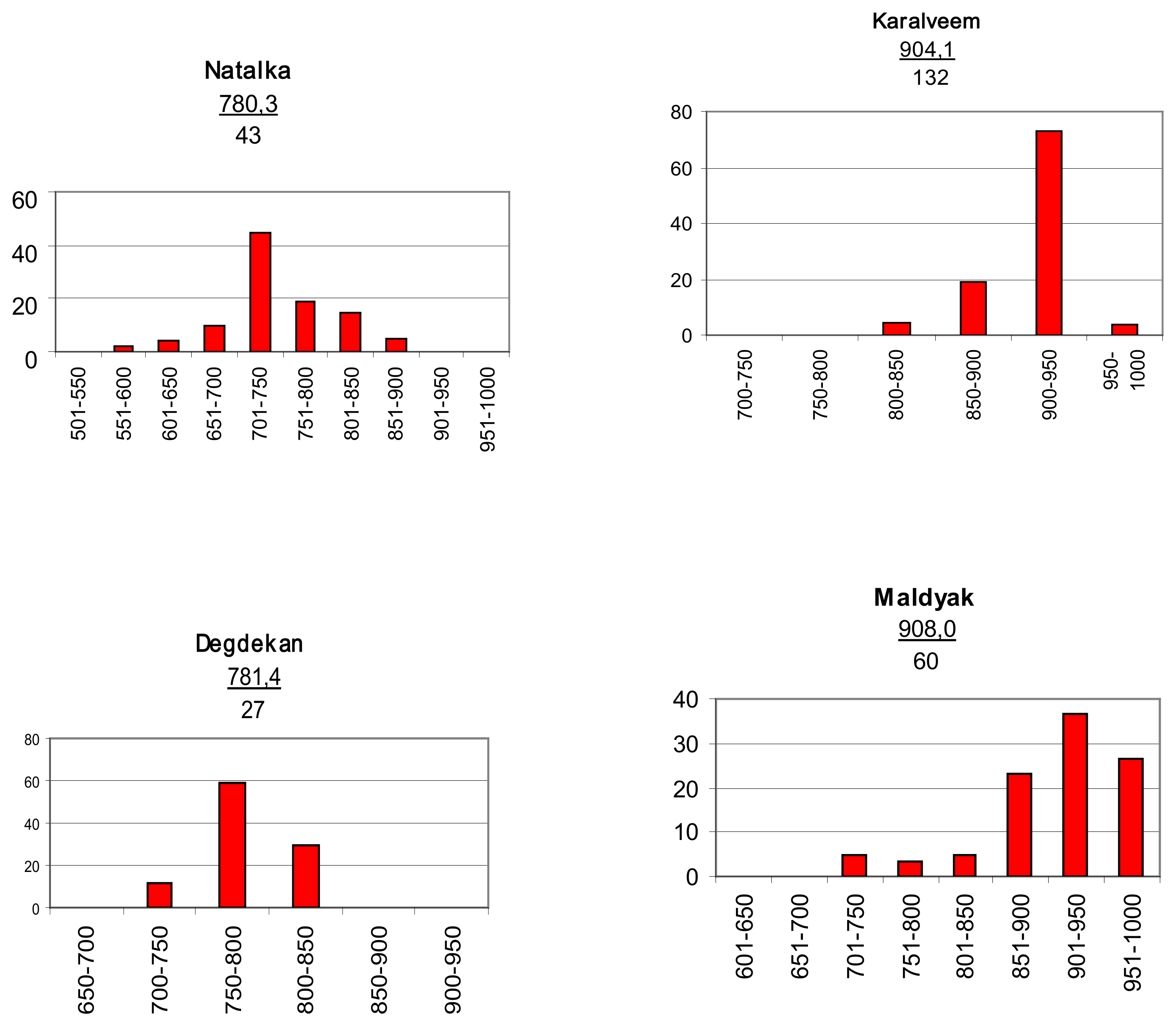
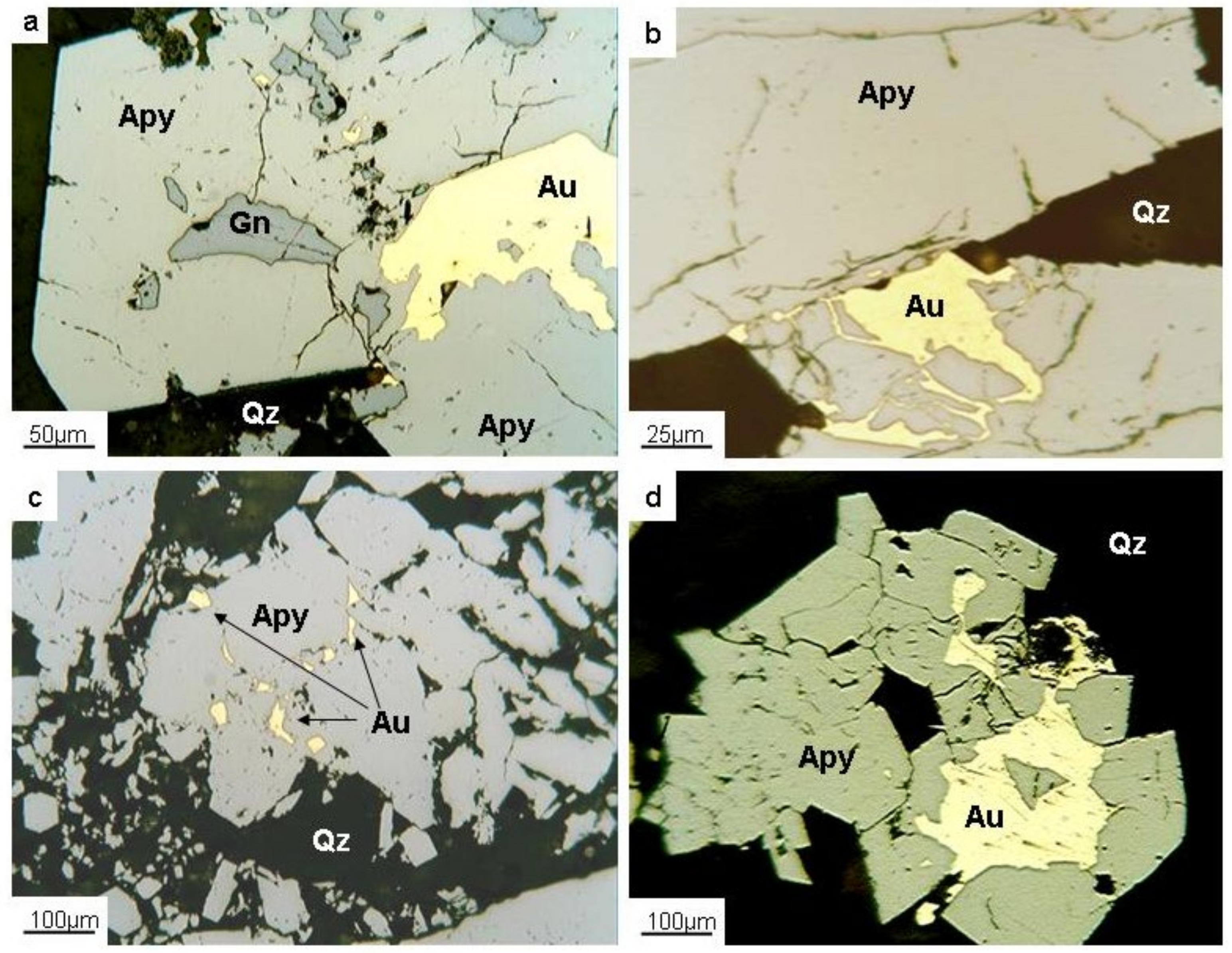
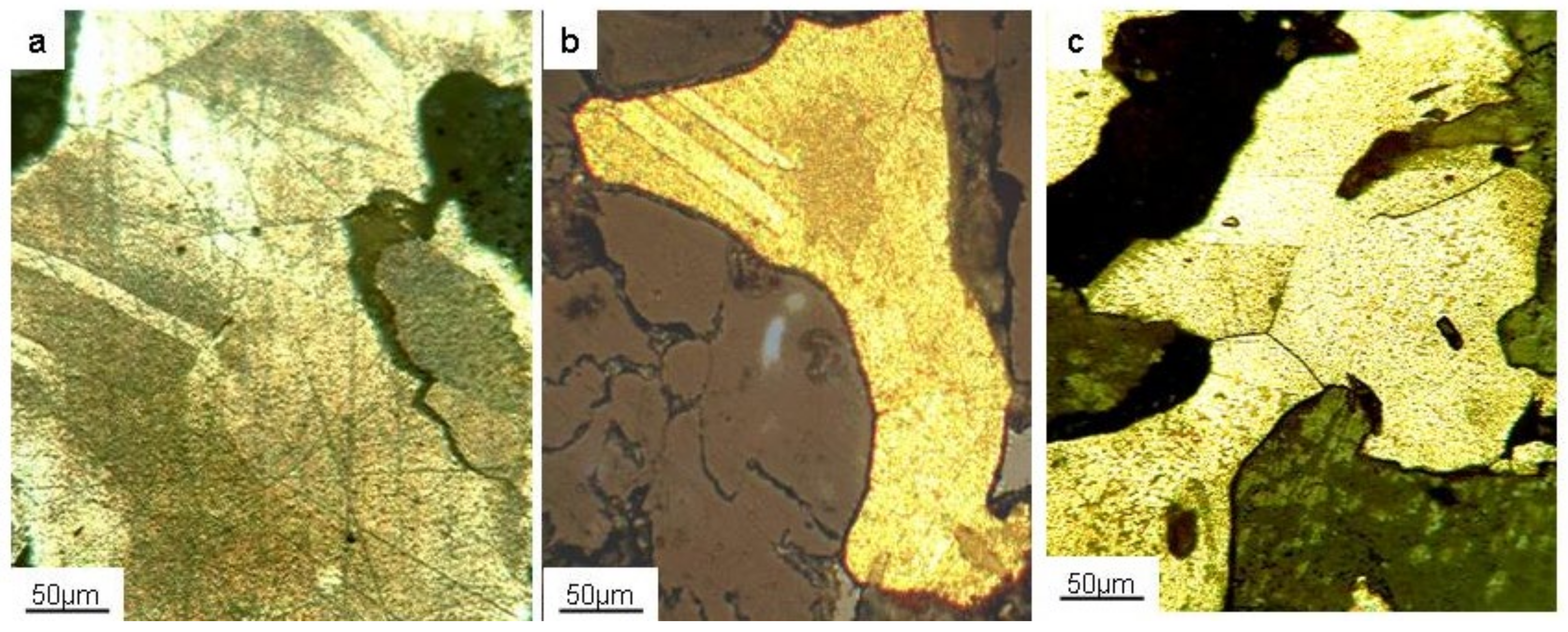
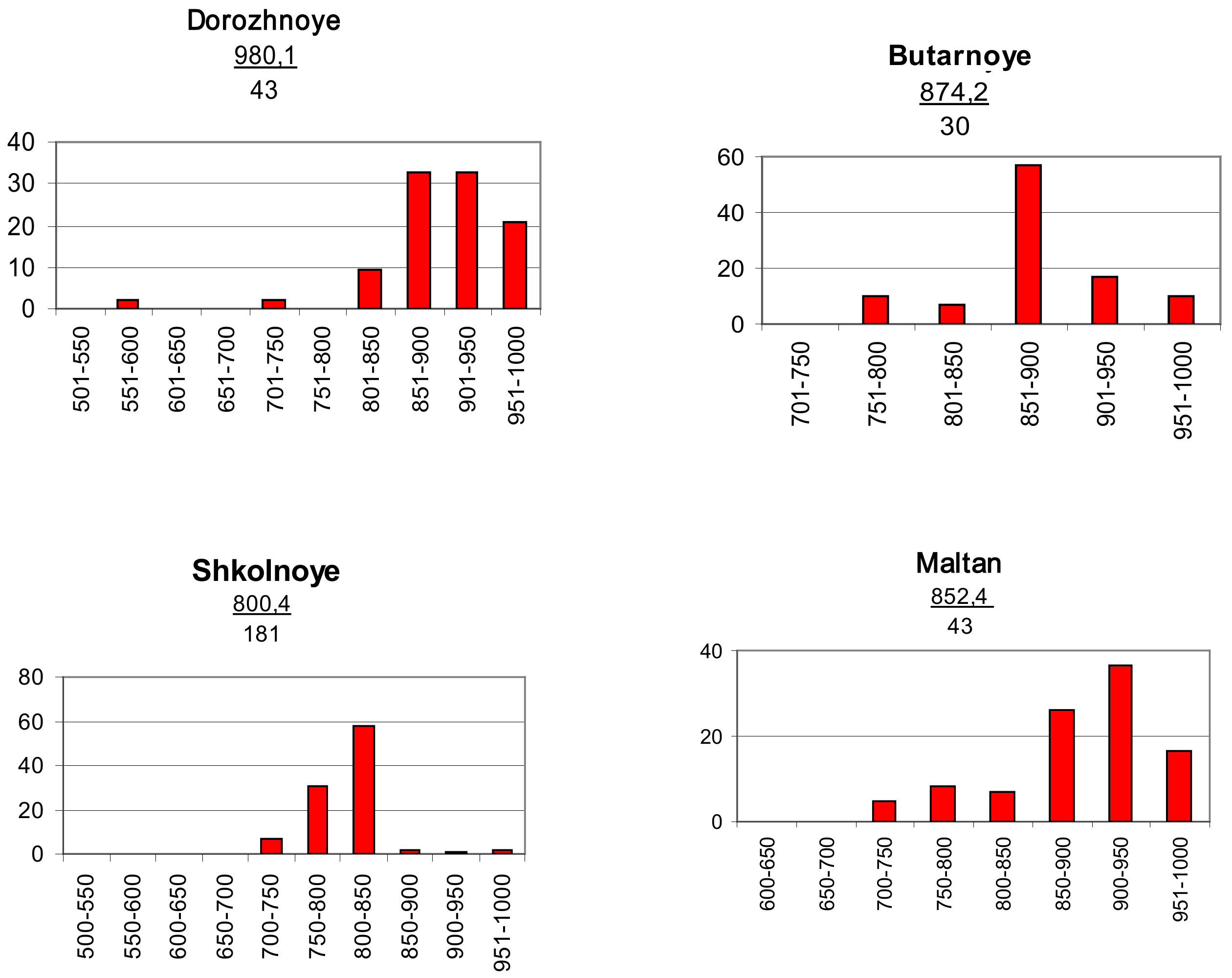
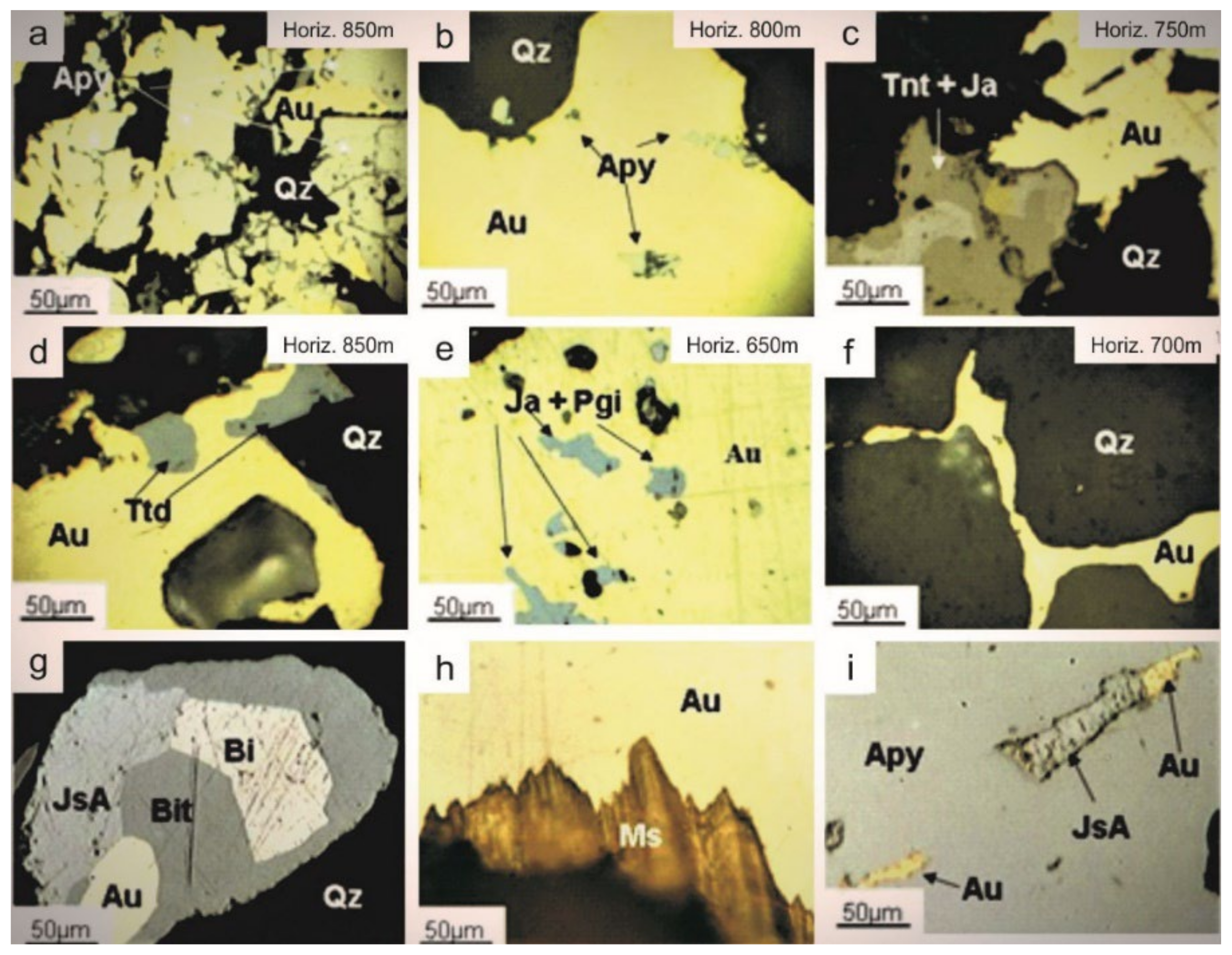
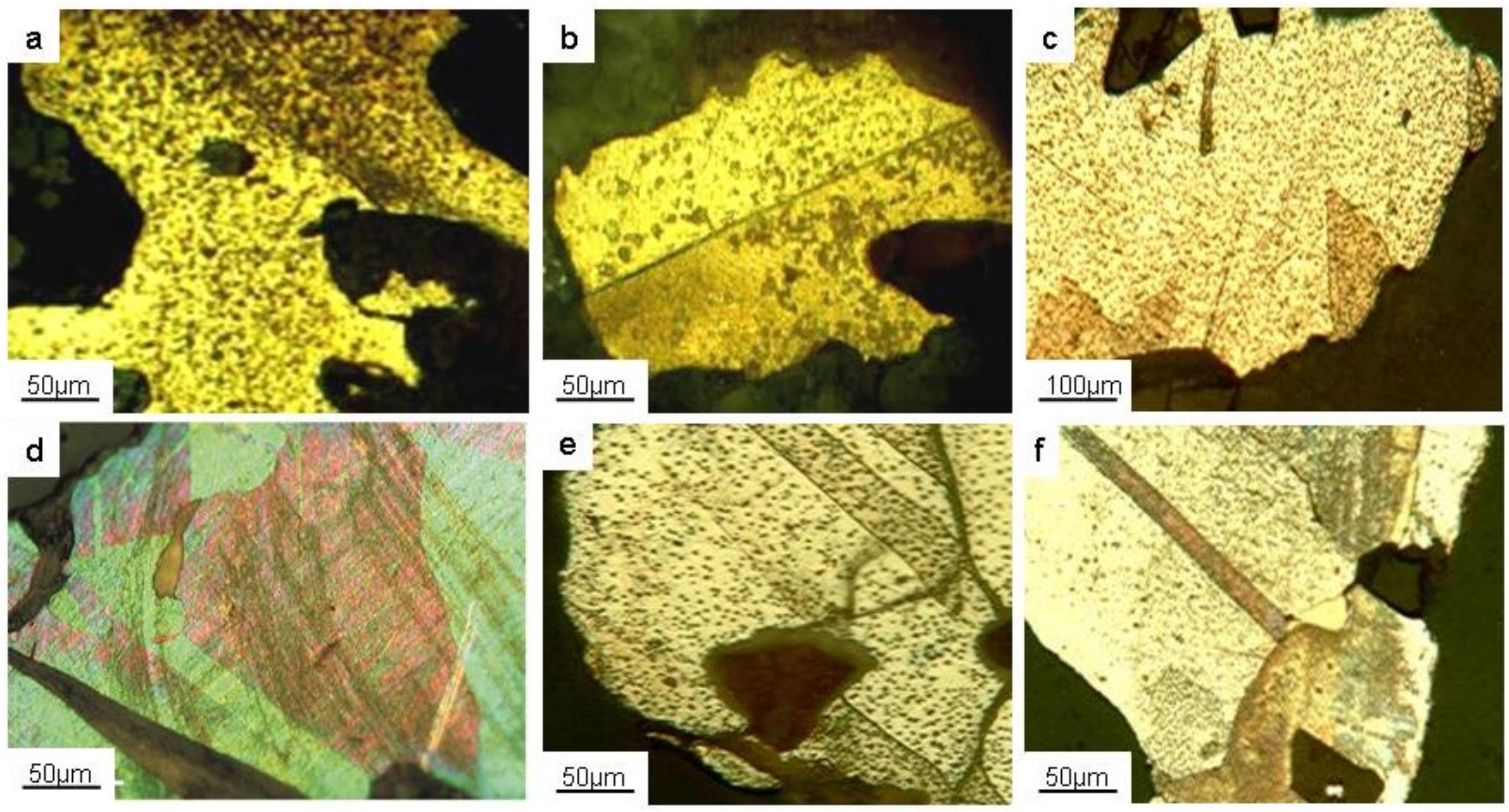
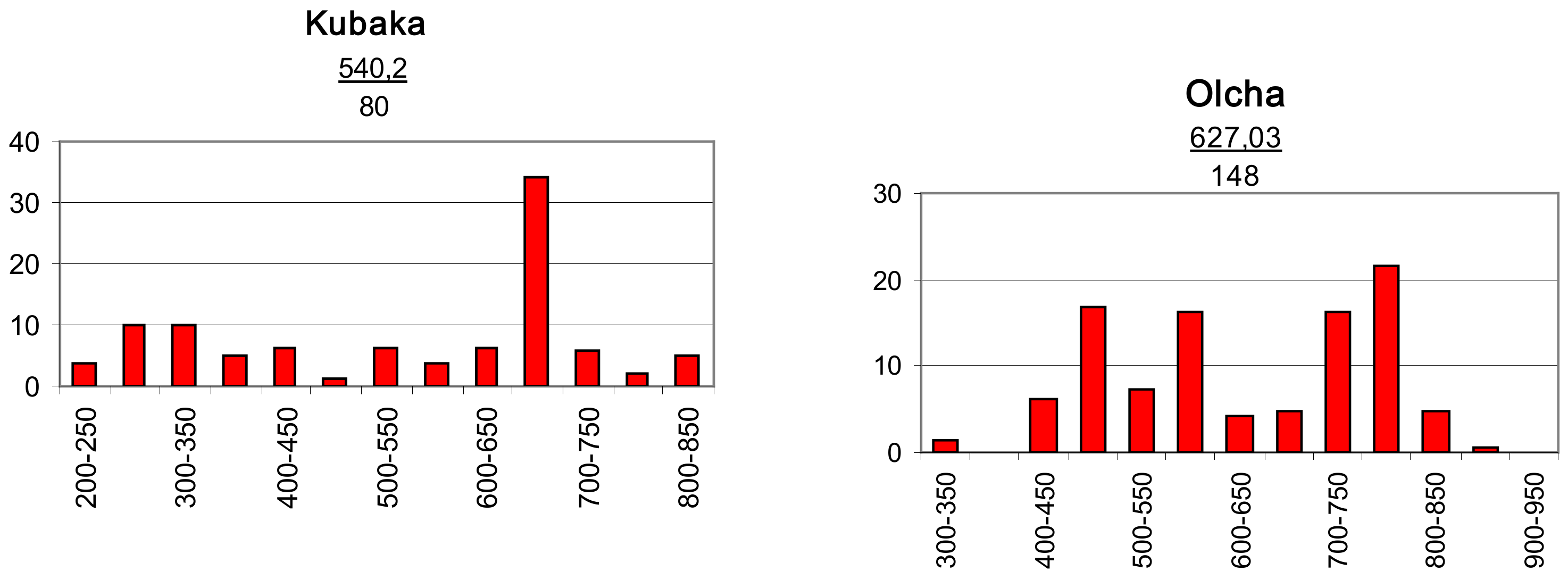
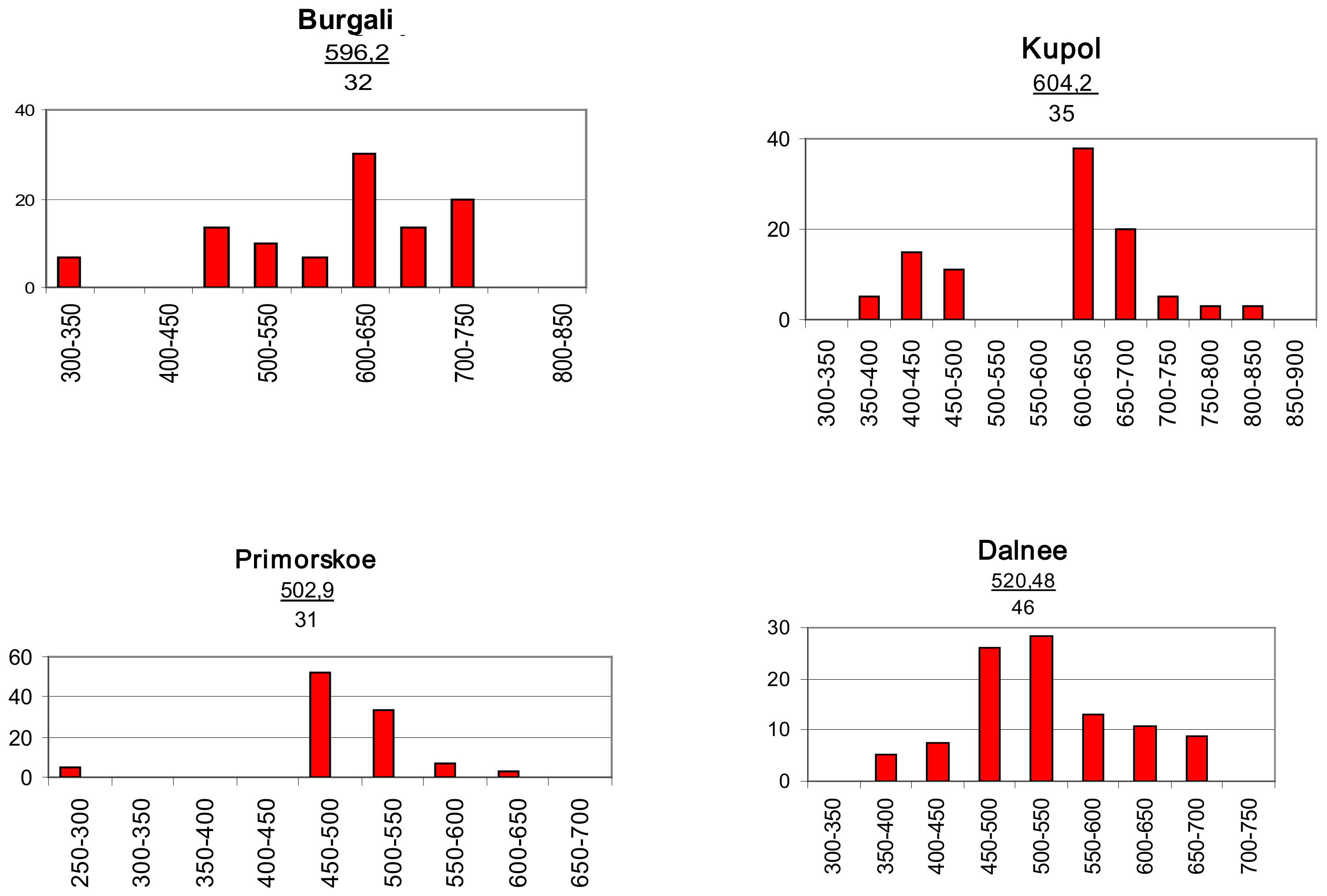
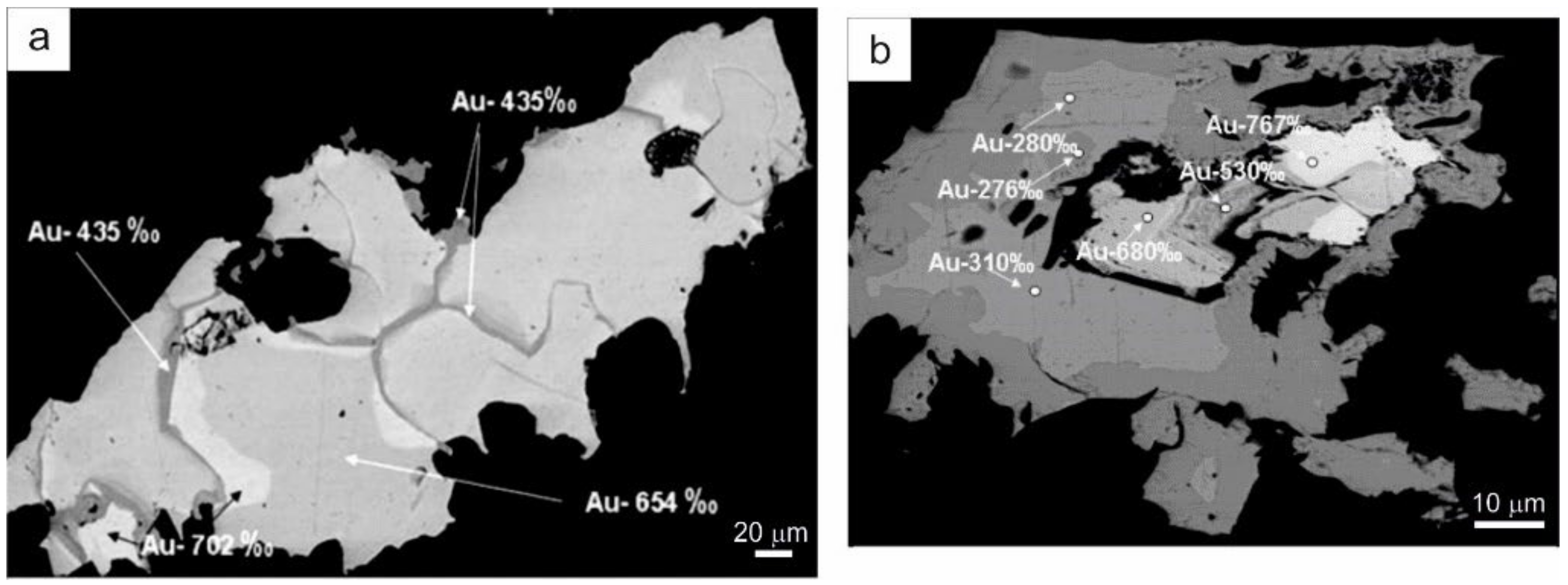
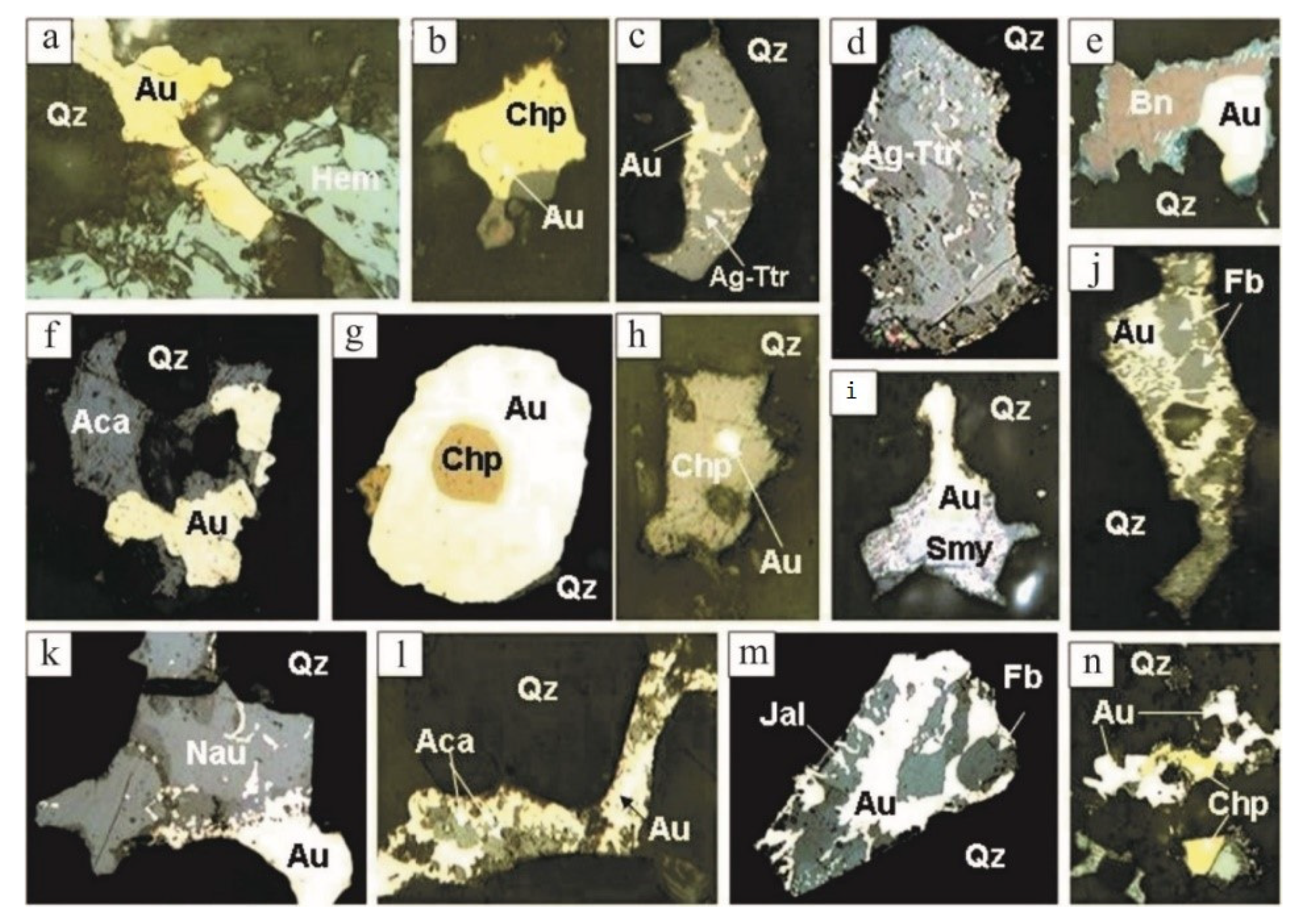
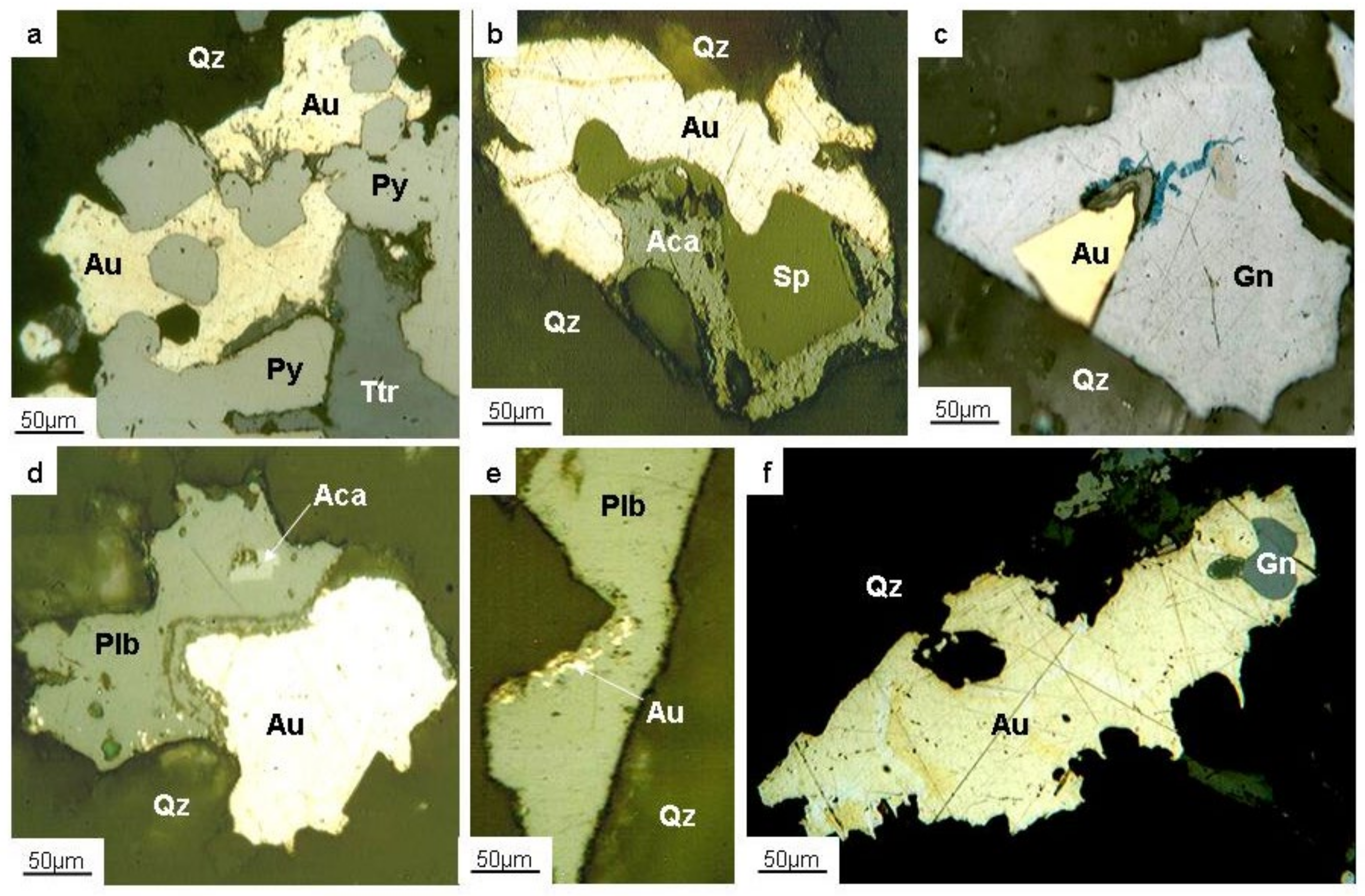
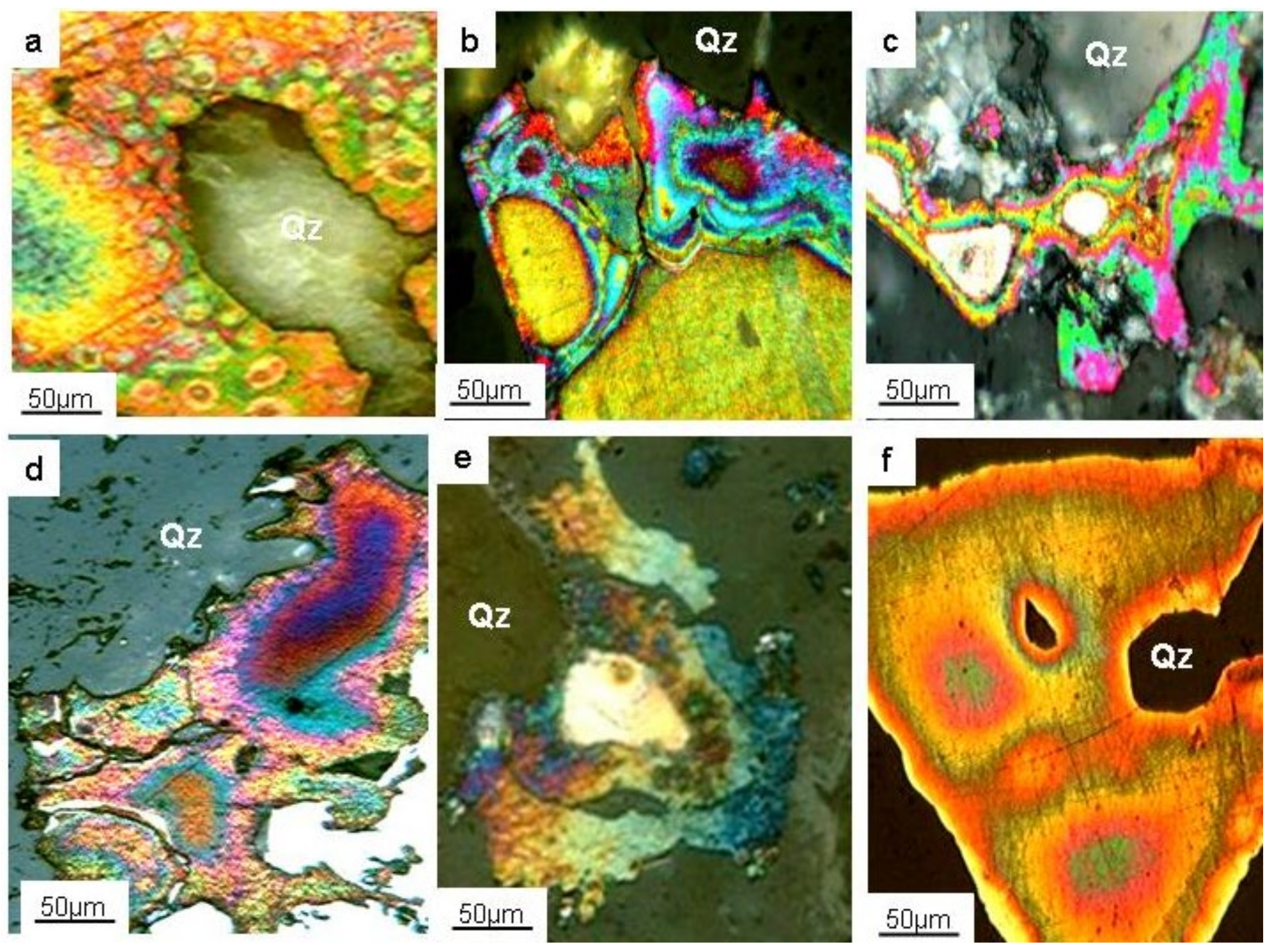
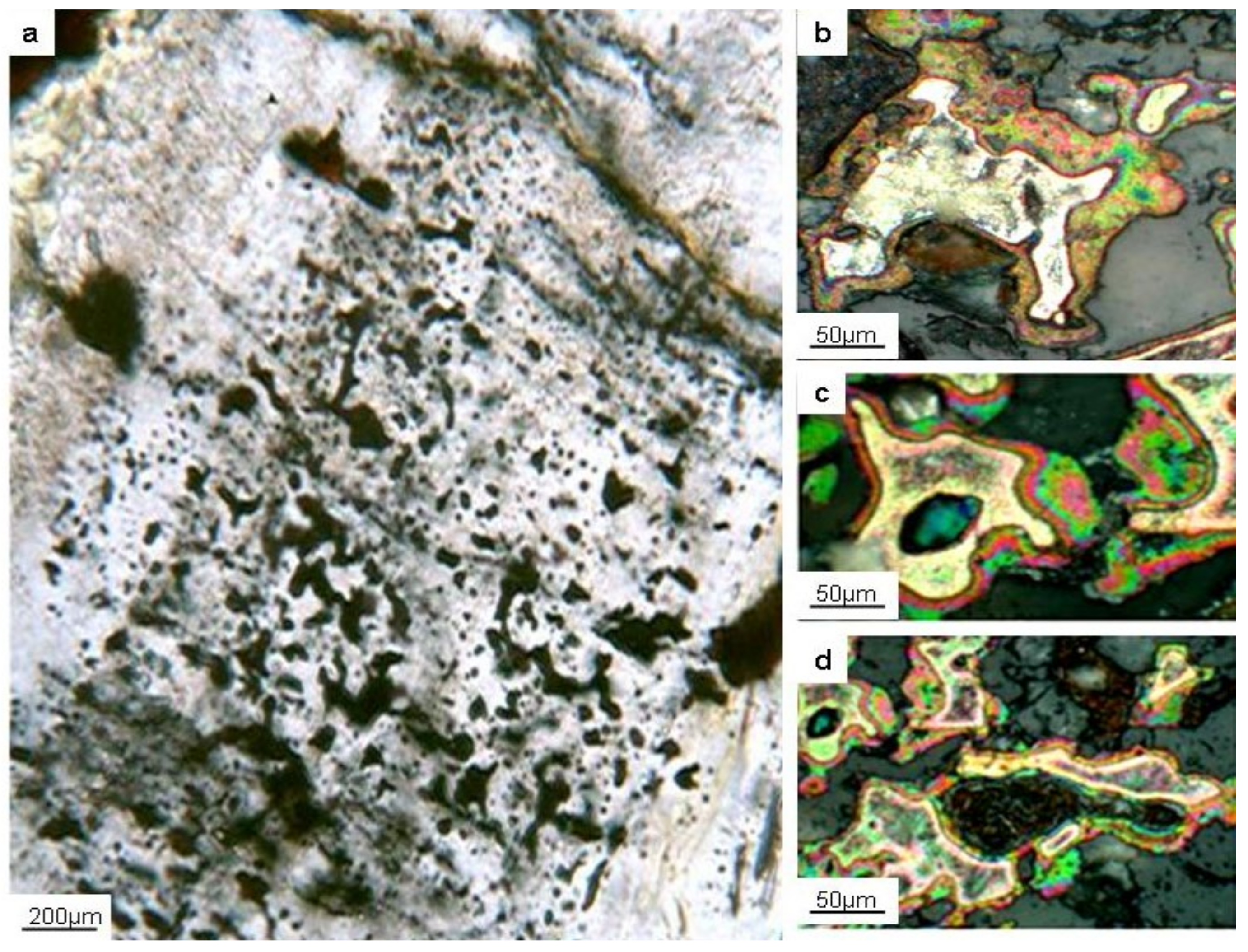
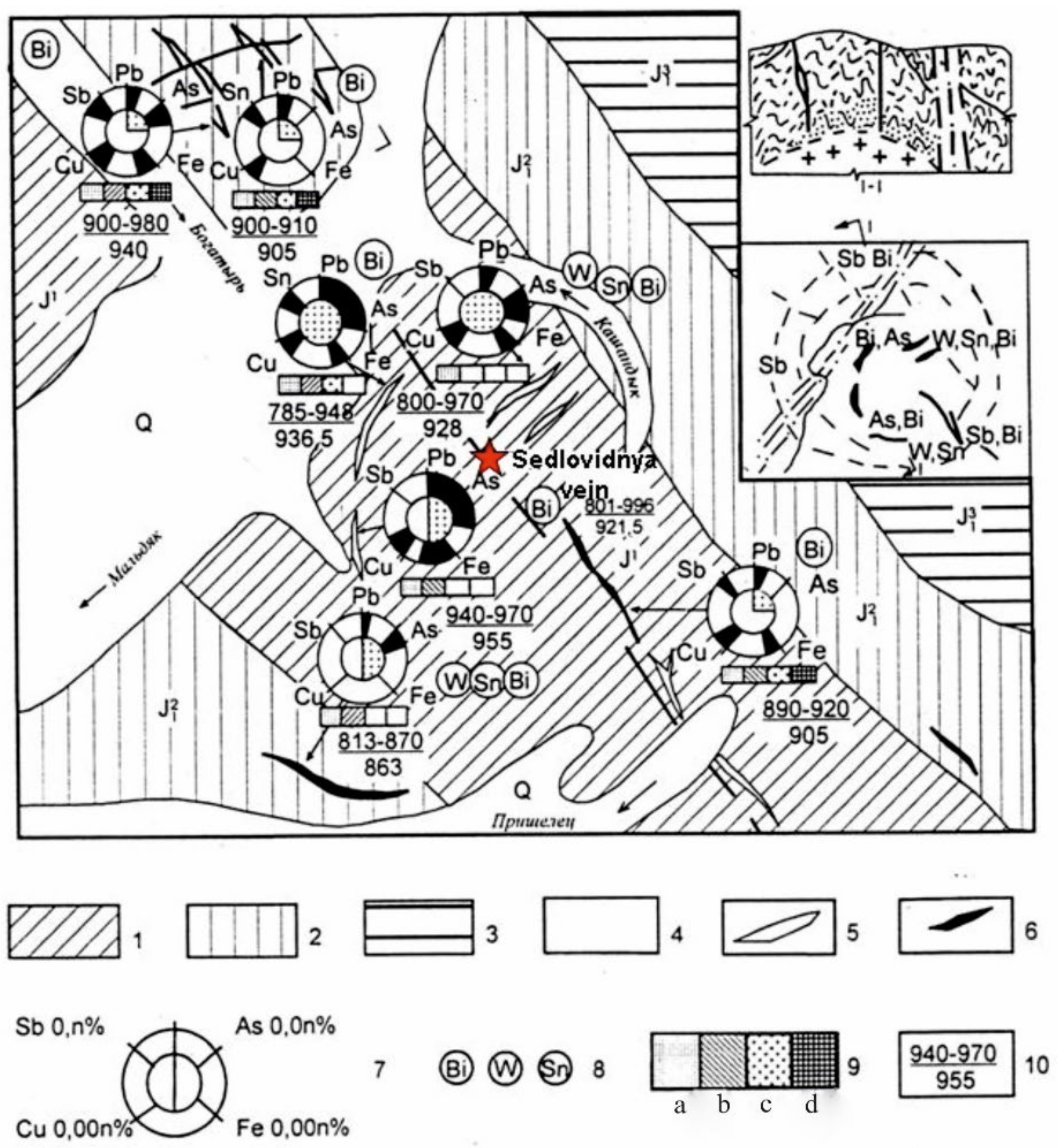
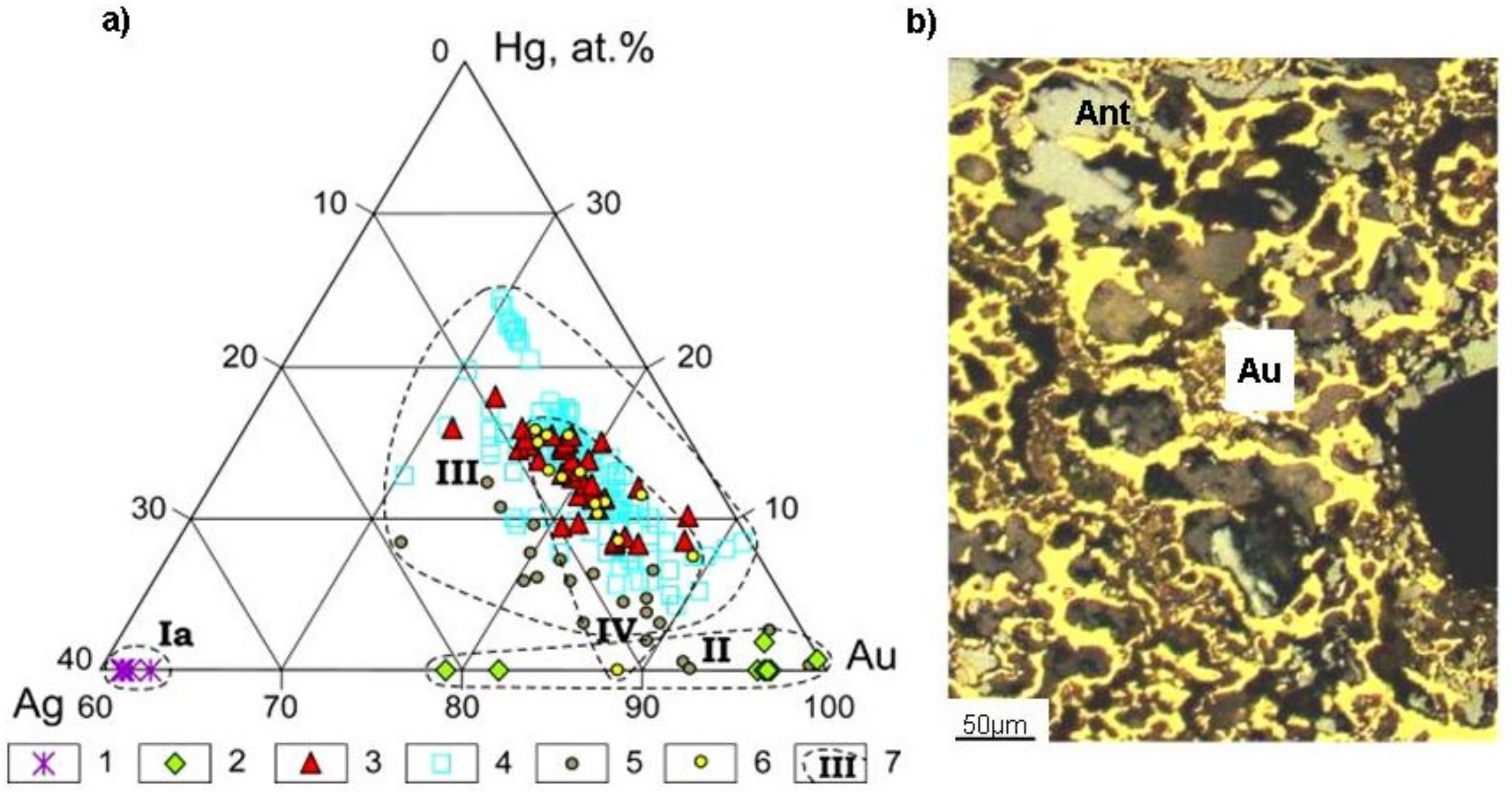
| Deposit (No. in Figure 1) | Element Concentrations, g/t | |||||||
|---|---|---|---|---|---|---|---|---|
| As | Sb | Cu | Bi | Fe | Hg | Pb | Sn | |
| Natalka (1) | 0.5–18.7 | 1.5–16.0 | – | – | – | 0.5–12.2 | 1.0–17.0 | – |
| Degdekan (2) | 1.0–41.0 | 0.1–11.3 | 10.2–35.3 | – | 1.5–9.6 | – | – | – |
| Maldyak (3) | 8.4–89.2 | 1.2–37.9 | – | 0.1–5.7 | 1.0–10.5 | – | 0.7–12.5 | 0.01–5.4 |
| Karalveem (4) | 5.0–120.1 | – | 1.0–45.5 | – | – | – | 0.5–10.4 | – |
| Deposit (No. in Figure 1) | Element Concentrations, g/t | |||||||
|---|---|---|---|---|---|---|---|---|
| As | Sb | Cu | Bi | Fe | Hg | Pb | Sn | |
| Shkolnoye (5) | 100.0–300.0 | 1.0–30.0 | 1.0–7.5 | 1.5–12.4 | 30.0–100.4 | 30.1–99.6 | – | 1.7–31.1 |
| Butarnoye (6) | 0.8–100.0 | – | – | 1.5–22.3 | 1.0–12.7 | – | – | – |
| Dorozhnoye (7) | 1.0–15.3 | – | – | 1.5–21.0 | – | – | 1.0–82.0 | – |
| Maltan (8) | 10.0–150.0 | 2.5–16.3 | – | 1.0–50.0 | – | – | 1.5–12.3 | – |
| Horizon, m | Scatter of Fineness Values Average, ‰ | Fineness Dispersion | Mineral Paragenesis |
|---|---|---|---|
| 850 | 250–850 775.4 | 11,375 | Native gold + quartz + arsenopyrite + fahlore |
| 800 | 700–850 782.7 | 1060 | Native gold + quartz + arsenopyrite + tennantite |
| 750 | 750–850 804.9 | 271.5 | Native gold + quartz + arsenopyrite + tetrahedrite + jamsonite |
| 700 | 700–800 753.5 | 223.5 | Native gold + quartz + arsenopyrite + tetrahedrite |
| 600 | 750–850 806.4 | 191.5 | Native gold + quartz + arsenopyrite + jamsonite + plagonite |
| Deposit (No. in Figure 1) | Element Concentrations, g/t | |||||||
|---|---|---|---|---|---|---|---|---|
| As | Sb | Cu | Bi | Fe | Hg | Pb | Sn | |
| Kubaka (9) | – | 0.8–1.3 | 0.6–35.0 | – | 1.5–15.0 | 0.5–60.0 | ||
| Kupol (10) | 0.1–27.3 | 0.1–25.5 | – | – | 0.1–1700.0 | |||
| Olcha (11) | – | 1.3–16.4 | 0.8–45.3 | – | – | 0.7–45.5 | ||
| Burgali (12) | – | 2.4–12.8 | 0.1–16.4 | – | 0.8–26.2 | 0.5–11.8 | ||
| Primorskoye (13) | 0.1–0.9 | 1.0–12.3 | 2.0–68.4 | 1.0–24.4 | 0.3–14.7 | 0.1–65.2 | ||
| Dalnee (14) | 2.7–12.1 | 1.5–21.1 | 0.1–7.3 | – | – | 0.1–1000.0 | ||
| Geological and Industrial Type | Fineness Variations, ‰ Dispersion | Microimpurities | Mineral Intergrowths | Internal Structures |
|---|---|---|---|---|
| Gold–arsenic-sulfide in black shale strata | 780–908 408–1746 | As (Pb) | Quartz + arsenopyrite + galena | Polygonal-grained with simple twins |
| Gold–quartz veins in granitoids | 852–980 2127–5626 (191–11,375) * | As, Bi, Sn (W) | Quartz + arsenopyrite + minerals BiTe + Sb-Fe- (Ag) sulfosalts | Proligonal-granular with patchy heterogeneity |
| Gold–silver adularia | 502–627 6320–17,287 | Sb, Cu, Hg (As, Fe) | Quartz + hydromica + Pb, Zn Cu sulfides + pale ores + Ag sulfides and sulfosalts + Ag, Cu, Pb selenides | Clear and unclear zonal with border extension |
Publisher’s Note: MDPI stays neutral with regard to jurisdictional claims in published maps and institutional affiliations. |
© 2022 by the authors. Licensee MDPI, Basel, Switzerland. This article is an open access article distributed under the terms and conditions of the Creative Commons Attribution (CC BY) license (https://creativecommons.org/licenses/by/4.0/).
Share and Cite
Savva, N.E.; Kravtsova, R.G.; Anisimova, G.S.; Palyanova, G.A. Typomorphism of Native Gold (Geological-Industrial Types of Gold Deposits in the North-East of Russia). Minerals 2022, 12, 561. https://doi.org/10.3390/min12050561
Savva NE, Kravtsova RG, Anisimova GS, Palyanova GA. Typomorphism of Native Gold (Geological-Industrial Types of Gold Deposits in the North-East of Russia). Minerals. 2022; 12(5):561. https://doi.org/10.3390/min12050561
Chicago/Turabian StyleSavva, Natalia E., Raisa G. Kravtsova, Galina S. Anisimova, and Galina A. Palyanova. 2022. "Typomorphism of Native Gold (Geological-Industrial Types of Gold Deposits in the North-East of Russia)" Minerals 12, no. 5: 561. https://doi.org/10.3390/min12050561
APA StyleSavva, N. E., Kravtsova, R. G., Anisimova, G. S., & Palyanova, G. A. (2022). Typomorphism of Native Gold (Geological-Industrial Types of Gold Deposits in the North-East of Russia). Minerals, 12(5), 561. https://doi.org/10.3390/min12050561






